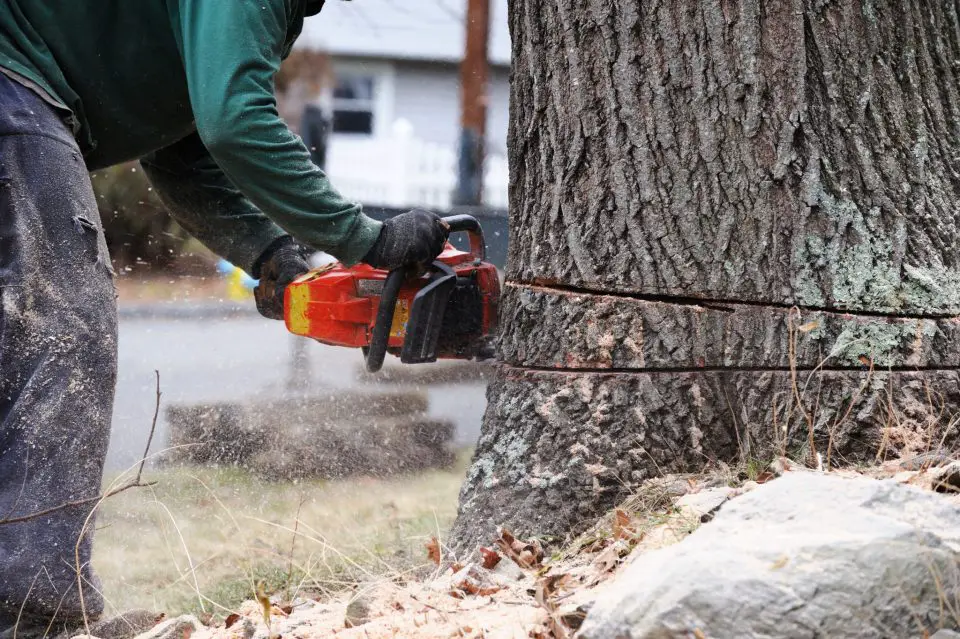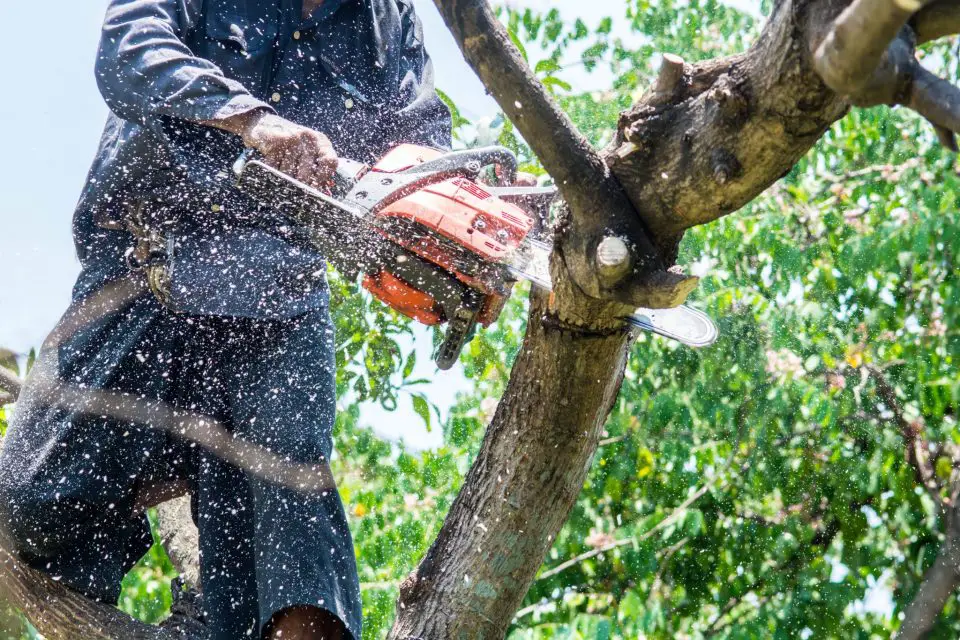
Among all do-it-yourself projects, felling trees is one of the most dangerous. Although you’re the one who has to take personal responsibility for results, felling delivers one of the most satisfying results and big financial savings compared with hiring a professional. There are different reasons you’d want to remove a tree from your property, then there’s always cutting firewood, too. Whatever your plans, you should consider a few precautions before you go out with your chainsaw. Don’t take tree felling lightly.
Felling a tree safely requires knowledge and skill. It also needs the proper equipment. That’s why some people hire a professional. Professionals also carry insurance, so risk reduction is a big part of why homeowners hire this job out. But if you want to fell a tree on your own, check out these Dos and Don’ts.
Do: Safety First

That’s part of my tree cutting setup above. Beyond the chainsaw you’ll be using, you’ll need:
- Hard hat
- Chainsaw pants or chaps
- Earmuffs
- Safety goggles or glasses
- Work gloves
- Safety-rated workboots
These will protect you from noise and some cutting hazards during the process. Make sure you’re covered head-to-toe in safety gear so you can avoid possible injuries. Aside from safety gear preparation, you must also consider how to work chainsaw safety into what you do. Start by looking carefully at the tree.
How to Fell a Tree: Analyze The Tree And Its Area
It’s a given that most mature trees are taller than a two-story home. Therefore, they could land on nearby objects and damage them when they fall. Before you start sawing, assess the area and the tree itself.
Don’t forget to check the area you’ll be working on since, as mentioned, there may be structures nearby. Make sure you note the location electrical lines, buildings, and vehicles to avoid mishaps. There might also be other trees in the surroundings, so you have to look out for those. If you think it’s too crowded to cut one tree, you may need to call for professional help. Rule of thumb: If your tree is any closer to a building or something valuable than twice the height of the tree, call in a pro. It’s surprising how much “longer” trees are than how they appear standing upright.
After you’ve analyzed the area, it’s time to assess the tree. Not all trees should be cut down since some may be diseased. You can tell if one has many dead or broken branches. If the tree is heavily lopsided, or has dead areas that could break off, fall and hurt you, the risk of trouble rises. But if the tree is healthy and symmetrical, it may make sense to cut it yourself. Also, check if there’s nothing on the tree such as animals or a tree house.
You can estimate the tree’s height by holding an axe at arm’s length. Close an eye, then walk away from the tree until its top and bottom align with the axe’s top and bottom. The spot you’re standing should be where the treetop will land if it were cut, but double that distance to determine a safe margin for error.
How to Fell a Tree: Plan An Escape Route
Even after analyzing the tree and surrounding area, it’s crucial to have an escape route ready, too. You never know when things might go wrong and you’ll need to make a speedy escape. Cutting notches in the trunk with your saw should ensure the tree falls in your intended direction, but gravity and physics are funny sometimes. You have to find a way out in case the tree has a mind of its own (which they sometimes do).
Plan at least two different escape paths, preferably on the non-fall side of the tree. Routes around 45 degrees to each other should suffice. Clear out any rocks, large sticks, and bushes that may obstruct your escape. It’s extra work, but it’s vital for your safety.
How to Fell a Tree: Work With a Partner
Some DIY home projects are fine when done alone, but felling trees isn’t one of them. You should have a partner nearby if you cut down a tree. This person will be your lookout and assistant for other needs you may have while cutting trees.
Having a lookout is essential when tree-felling because you won’t be able to focus on possible branches falling or bystanders walking too close. It’s best if your lookout person is standing a couple of feet behind you with a decent view of the rest of the tree. They should also have a long stick or rod with them. Since they’ll be far from you, they need a way to signal. So, the stick is there for them to poke you in case of incoming danger over the noise of the saw.

How to Fell a Tree: Go In Unprepared
DIY projects are exciting, especially if it’s something like cutting down a huge tree. However, it’s not that easy, and there are risks. If you’ve never done it, consider talking with an experienced tree feller first. They won’t tell you anything you haven’t read here, but it’s still worth the trouble.
You can find many tree-cutting tutorials in the form of blogs or videos from experts and DIY enthusiasts. Choose a few that you think have comprehensive guides and learn from there. The process could become second nature to you. Eventually, you can turn trees into firewood, too. So, take enough time to study how it’s done and practice if you need to.
How to Fell a Tree: Get Hasty
Once you’ve felt that the tree’s about to fall, stay observant because anything could happen before it hits the ground. Never turn your back on a falling tree as you walk away. Always keep it in sight as it goes down, while you and your lookout head to the escape routes. Doing this ensures your safety and should result in a precise landing for the tree.
Conclusion
Felling a tree is an excellent way to make firewood, to make more space on your property, or remove a tree that’s dead or dying. But since most trees are tall, it’s essential to practice safety while you’re doing it. These tips should guide you in making your tree-felling project successful.












